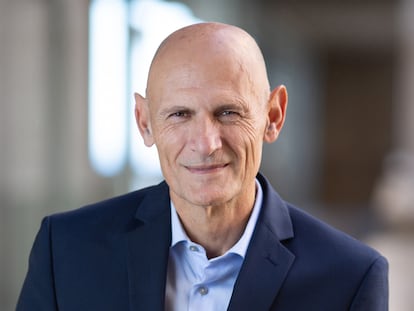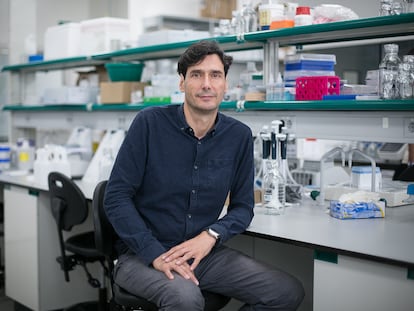Why living up to the age of 130 is a ‘reasonable’ proposition
Spanish scientist Corina Amor talks to EL PAÍS about her revolutionary experimental treatment to destroy the cells responsible for aging and cancer

When she was just 27, Spanish immunologist Corina Amor presented a revolutionary doctoral thesis that proposed an experimental therapy to eliminate the cells responsible for aging and cancer. In youth, the human body’s defenses are capable of destroying these damaged cells, called senescent cells, but as life goes on, the immune system cannot cope and they start to build up. Amor’s team, led by American biologist Scott Lowe, devised a strategy to extract white blood cells – known as T-lymphocytes – from the patient and reengineer them in the laboratory to destroy senescent cells. Her proof of concept, in mice, was published two years ago in the prestigious science journal Nature.
The 29-year-old researcher has just founded her own research group, the Amor Lab, at the prestigious Cold Spring Harbor Laboratory in New York, thanks to a program for promising young scientists. Modified T lymphocytes, known as CAR-T, are already being used successfully to treat certain lymphomas and leukemias, but Amor’s team was the first to show that they could be transformed to eliminate senescent cells.
Question. Some therapies to eliminate senescent cells with drugs have managed to increase the lifespan of mice.
Answer. Yes, it was first seen in genetically modified mice – if you removed their senescent cells, they lived longer. There has been a lot of interest in trying to replicate these results with drugs that could be given to humans. One of the first studies was done with drugs called Dasatinib and Quercetin and an improvement was seen [the mice in the experiment lived 36% longer]. We wanted to investigate whether our CAR-T cells could do the same thing. And we’ve seen some big improvements in aging.
Q. Have you managed to increase lifespan?
A. We’ve seen some increase in lifespan, but mostly in how long [the mice] were healthy. For example, at the metabolic level, these mice have much better glucose tolerance. With age, you develop type 2 diabetes, but these mice don’t. And they are in better physical condition.
Q. The director of Spain’s National Oncology Research Center (CNIO), María Blasco, wrote a book with journalist Mónica Salomone called Morir Joven, a los 140 or, Dying young, at 140. The book said the oldest animal in the world is a clam from Iceland that lived 507 years. If a clam can live that long, why can’t humans? Can aging be controlled with therapies targeting senescent cells?
A. I think we're going to see a lot of improvement in terms of the quality of life that we have, until a much later age. But I don't think we're going to greatly extend the maximum lifespan that we have as a species.
Q. Why are you so pessimistic?
A. I think life expectancy is determined at the genetic level. I would be satisfied if we could live up to 100 years with a good quality of life, feeling well, going out every day, being independent. That would seem like a pretty significant advance to me.
Q. In the book, it was mentioned that a rat lives three years and a squirrel lives 25. This suggests that the rat could live eight times as long with small changes.
A. Other groups have created genetically modified animals to eliminate all senescent cells and achieve a longer life expectancy, but the increase is not that significant. It’s like 10% or 20% more.
Q. If our senescent cells are eliminated, do we age the same?
A. You don’t age the same: you age slower and live longer. But you’re going to die anyway at some point.
Q. You don’t believe that the human lifespan can be extended?
A. I think it can be extended, maybe it can be doubled.
Q. Doubling a lifespan of 80 years would mean living for 160 years.
A. That’s stretching it a lot. I think 120 or 130 is reasonable.
Q. The geneticist Ginés Morata stated that death is not an inevitable biological process, since there are living beings that do not age, such as some coelenterates.
A. Yes, but not mammals. Sorry to be so pessimistic. One of the issues that I notice in the field of aging is that people tend to demand too much. It’s okay to be optimistic and I’m generally very optimistic, but I think it’s more important to focus on what we can actually do, which is to increase quality of life and maximize lifespan. But to say that we are never going to die...
I would be satisfied if we could live up to 100 years with a good quality of life
Q. When are you going to make the leap to humans?
A. My previous hospital, Memorial Sloan Kettering Cancer Center in New York, is trying to start a company, with the goal of doing a clinical trial in two years.
Q. What condition would be treated?
A. That’s what we’re deciding now. We are thinking of liver fibrosis induced by nonalcoholic steatohepatitis. It is related to food, with diets rich in fat, but sometimes it is irreversible. It is the leading cause of liver transplantation. There is a large affected population.
Q. Could CAR-T treatment against senescent cells be offered widely to the public?
A. The thing with CAR-Ts is that you always have to isolate the cells from the patient and re-inject them. It is a very expensive process, honestly. The grail that everyone is looking for is to get a standard treatment, something universal that you can inject into any patient, but it is difficult.
Q. These complex treatments are now being considered for people who are very seriously ill.
Q. Yes, in Spain they do CAR-T at Barcelona’s Clínic Hospital, for example, or in La Paz Hospital in Madrid, but it is the last option for patients who have already had all lines of treatment. This strategy, to eliminate senescent cells, has potential in some chronic diseases, such as pulmonary fibrosis, whose patients live as little as a patient with metastatic pancreatic cancer. It is a clinical need, but in order to universalize these treatments, they would have to be much less expensive, and not so specific to each patient.
Q. A few months ago, an experimental therapy with CAR-T developed by Barcelona’s Clínic Hospital put 18 patients with multiple myeloma in complete remission. In private pharmaceutical companies, this treatment costs about €300,000 ($312,000) per person, but the Clínic Hospital managed to do it for €90,000 ($94,000).
A. Yes, but even then it’s a lot. It is an expensive field to work in. An experiment on mice can cost $10,000 or $20,000.
Q. One of the problems with CAR-T is that in some patients there is a cytokine storm, an overreaction of the human body’s defenses. Have you detected this problem?
A. Yes, we’ve seen it, but it depends a lot on the dose. We saw that we can lower the dose and that it is equally effective, without having toxicity, which is the most common side effect in these patients.
P. If your CAR-T therapy works and has no side effects, what might it be used for?
A. For many chronic diseases: liver fibrosis, pulmonary fibrosis, diabetes. I think it could have many applications.
Q. In cancer too?
A. Yes, we have used it as a therapy, but by first inducing senescence in tumor cells and then giving CAR-T. It’s what they call the one-two punch approach [in reference to the combination of two direct punches in boxing, the one-two]. We used it on lung cancer in mice and it worked pretty well.
Tu suscripción se está usando en otro dispositivo
¿Quieres añadir otro usuario a tu suscripción?
Si continúas leyendo en este dispositivo, no se podrá leer en el otro.
FlechaTu suscripción se está usando en otro dispositivo y solo puedes acceder a EL PAÍS desde un dispositivo a la vez.
Si quieres compartir tu cuenta, cambia tu suscripción a la modalidad Premium, así podrás añadir otro usuario. Cada uno accederá con su propia cuenta de email, lo que os permitirá personalizar vuestra experiencia en EL PAÍS.
¿Tienes una suscripción de empresa? Accede aquí para contratar más cuentas.
En el caso de no saber quién está usando tu cuenta, te recomendamos cambiar tu contraseña aquí.
Si decides continuar compartiendo tu cuenta, este mensaje se mostrará en tu dispositivo y en el de la otra persona que está usando tu cuenta de forma indefinida, afectando a tu experiencia de lectura. Puedes consultar aquí los términos y condiciones de la suscripción digital.
More information
Últimas noticias
Human rights activists, opposition members, and a minor: Maduro’s other political prisoners
Israel sparks a civil war within the MAGA movement
The complicated life of Francesca Albanese: A rising figure in Italy but barred from every bank by Trump’s sanctions
Pinochet’s victims grapple with José Antonio Kast’s rise in Chile
Most viewed
- Reinhard Genzel, Nobel laureate in physics: ‘One-minute videos will never give you the truth’
- Pablo Escobar’s hippos: A serious environmental problem, 40 years on
- Charles Dubouloz, mountaineering star, retires at 36 with a farewell tour inspired by Walter Bonatti
- Why we lost the habit of sleeping in two segments and how that changed our sense of time
- The Florida Keys tourist paradise is besieged by immigration agents: ‘We’ve never seen anything like this’











































